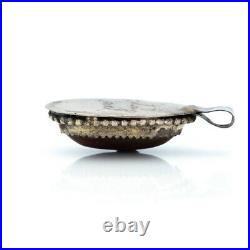Antique Vintage Sterling Silver Native Navajo Pawn Rainbow Jasper Pendant 7.5g





We have similar Jasper and Navajo items, which would pair nicely with this piece, for sale this week. Item Description by: Angela A. Markings: "Sterling" and unidentified maker's mark (appears to be "Jane") on the back of the pendant, tested, and guaranteed. Color: opaque olive green, blue, red, and orange hues. Stone Treatment: The stone(s) appear to be untreated, but we are not certified gemologists.
Stone(s) have been tested and guaranteed using a professional Presidium Duo refractive, heat, and hardness tester. Bale opening: 6.1 mm length, 3.29 mm width.
Handmade during the 1950s by a talented Navajo silversmith. Features a beautiful rainbow jasper stone.This stone rests in a saw tooth bezel setting. Sterling silver bead motifs surround the stone. Completed with a standard bale, enabling the pendant to be worn on a variety of antique chains or necklaces.
There are stress lines visible on the face of the stone, which would have been created naturally as the stone was forming; this does not affect wear. Tarnish on the sterling silver gives the pendant an antique quality we believe is rather lovely, but can be removed with a buffing, if desired. This listing is for the item only. This beautiful piece was made by a very talented Native American silversmith. It features handcrafted silversmith work throughout. Antique Native American jewelry is very rare to find. This is due to these pieces being made for reservation and personal use before the tourist trade became popular. Very few pieces were made and even less survived to today. The Navajo Nation sits on 27,000 square miles within the states of Arizona, New Mexico, and Utah. The Navajo have a rich history and culture and have become known for creating some of the finest sterling silver and turquoise jewelry, incorporating their own traditional motifs with silversmithing.The squash blossom necklace is perhaps one the most famous Navajo styles produced, along with turquoise inlay rings. Turquoise is an important stone in Navajo culture; symbolizing happiness, good fortune, and good health. The first Navajo silversmith, Atsidi Sani, was taught around 1865 by a Mexican silversmith. Atsidi Sani, in turn, taught his four sons, who then started teaching other Navajo artisans.
In the beginning, Navajo artisans created sterling silver jewelry for themselves and others in the Navajo Nation. The concept of Pawn, Old Pawn, and Dead Pawn Native American Jewelry came to be in the 1800s. When a loan wasn't repaid, the item became known as either "Old Pawn" or Dead Pawn. A form of chalcedony, jasper is an opaque mineral of virtually any color.
Jasper is often observed with patterns that occur during the mineral's formation. Certain forms of jasper such as the pale green variety have been popular since the ancient period; the Minoans on Crete favored green jasper for their seals, but green jasper was also popular among the Assyrians, Persians, Greeks, and Hebrews of antiquity. Hailed as a significant gemstone among the ancients, it was also used to produce objects larger than jewelry such as vases and other vessels.This item is in the category "Jewelry & Watches\Ethnic, Regional & Tribal\Necklaces & Pendants". The seller is "abeautifultimeco" and is located in this country: US. This item can be shipped worldwide.
- Country of Origin: United States, Navajo Nation
- Country/Region of Manufacture: United States
- Style: Pendant
- Modified Item: No
- Ethnic Origin: Navajo
- Type: Pendant
- Main Stone Color: Blue
- Metal Purity: .925
- Closure: Standard bale
- Main Stone: Jasper
- Brand: Jane
- Metal: Sterling Silver
- Tribal Affiliation: Navajo
- Era: Vintage Native Navajo c.
1950
- Ethnic & Regional Style: Native American
